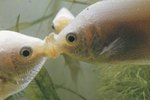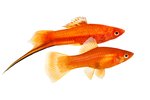Patient hobbyists have spent years breeding the different South American cichlids, sometimes crossing completely different species to produce fish that are never found in the wild. Kissing parrot fish, more commonly known as blood parrot fish or blood parrot cichlids, are a lively example of these artificial hybrids. As you might have guessed, their habit of locking lips isn’t kissing at all. It is a relatively gentle form of fighting – the fish are wrestling.
Background
The ancestry of the blood parrot cichlid is not entirely certain, but it is most probably a cross between the midas cichlid (Cichlasoma citrinellum) and the redhead cichlid (Paraneetroplus synspilus). In the wild, these two species would never meet, with the midas cichlid inhabiting the rivers of Costa Rica and Nicaragua while the redhead lives further north in Central America, although they are closely enough related to produce fertile offspring.
Tank
Because of their size, blood parrot cichlids can grow to at least 10 inches long, the amount of mess they produce and the fact that they are quite territorial, this variety needs a large tank. The absolute minimum is 40 gallons for one fish and 50 gallons for two, but the more space you provide, the better. Use a soft substrate, such as sand, and arrange rocks to provide a variety of hiding places. You also need a heater, a light and a powerful filter. Maintain a temperature of about 76 to 86 degrees Fahrenheit. Keep the pH fairly neutral – anything between 6.5 (very slightly acidic) and 7.5 (very slightly alkaline) is fine.
Diet and Care
Like other cichlids, this variety needs several small meals a day. Sinking pellets for cichlids form a good basic diet, which you can supplement with some live food, such as daphnia and bloodworms. Some hobbyists recommend also providing a few cooked, cooled peas once a week, which may help prevent swim bladder problems. Regular partial water changes are crucial to maintain water quality. Remove one-fifth to one-quarter of the water along with any debris once a week using a gravel cleaner and bucket before replacing with fresh, dechlorinated water.
Considerations
Healthy blood parrot cichlids can live for up to 15 years, making them a long-term commitment. It isn’t easy to rehome unwanted fishy pets, so think carefully about your future plans before setting up a tank. Although there are no conservation issues associated with the keeping of blood parrot cichlids – these fish aren’t found in the wild so there is no question of wild populations being depleted – there are some animal welfare considerations. Deliberate mutilation of these fish, including dyeing and tail amputation, sometimes occurs in a cruel attempt to make them more appealing to buyers. If you see such fish for sale, boycott the store and check to see if the practices are legal in your area. If not, file a report with the appropriate authorities, usually local government.
References
Resources
Writer Bio
Judith Willson has been writing since 2009, specializing in environmental and scientific topics. She has written content for school websites and worked for a Glasgow newspaper. Willson has a Master of Arts in English from the University of Aberdeen, Scotland.





